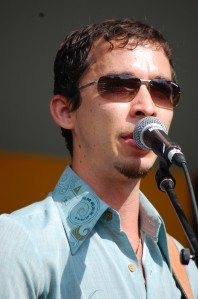I saw eleven one-performer shows at this year’s Fringe. I used to avoid them, preferring to see the interaction among characters rather than watching a single performer tell or recreate a whole story. But the genre has grown on me, first with my admiration for storytellers and then extending to performers who act out their narrative with props and multiple characters.
Ask Aggie – Christine Lesiak’s departure from her clown persona to be an “advice diva”, answering audience questions about romance and sex, interspersed with stories and songs about her experiences with five husbands. Funny, easy to listen to, and actually full of advice I didn’t disagree with.
They Call Me Mister Fry – Jack Fry tells stories about his first year of teaching elementary school, in inner-city Los Angeles. He shows slides of some student work to illustrate some of the stories. Reviewers seemed to like it more than I did. It was well delivered, but it’s a genre of story that I’m very familiar with.
RiderGirl – Colleen Sutton tells about becoming and being a part of RiderNation, the community of Saskatchewan Rough Rider fans, along with other changes in her life, such as leaving a military band appointment to study acting.
Nashville Hurricane – Chase Padgett’s narrative was held over for one show yesterday, which is no surprise. It was one of the best and most polished shows of any kind I saw this year. His characters were very distinct from each other, compelling and not all likeable.
Borderland – Izad Etemadi, from Victoria BC, used first-person narrative and three point-of-view characters to tell a story in tribute to people he’d encountered through a Toronto-based group Iranian Railroad for Queer Refugees.
Dykeopolis: Queer Tales and Travels for our Times – Kimberly Dark’s anecdotes, questions, and thought starters were a perfect example of the saying “the personal is political”. Through stories from her own life, starting from the first girl she was attracted to in high school, she illustrated important points about gender and sexuality in ways that the audience connected with.
Zack Adams: Zack to the Future: – Shane Adamczak, from Australia tells a silly story about time travel to the future. Many of the audience seemed familiar with his character from previous shows but it was my first time seeing him.
Canuck Quixote – Colin Godbout plays guitar and sings, and in between talks about the musicians and the songs and how they fit with themes of ethnic minorities and quixotic journeys. I like some of the music and I wasn’t familiar with all of it, and I still didn’t find the show compelling. Maybe his understated stage presence and lack of eye contact were too reminiscent of the title character of Nashville Hurricane.
Roller Derby Saved my Soul– Nancy Kenny recounted how discovering the sport of roller derby had changed her life as a 30-something single woman who “thought I’d have a more interesting job by now” and who struggled to get along with her mother and sister. The stage floor had a bit of derby track taped onto it. During the show she puts on roller skates and derby gear, and then delivers part of her story while skating. This was not as distracting as you might think. I really enjoyed it and found it inspiring.
Bad Guys Finish First – Gavin Williams starts off giving a self-help seminar about how to be successful by not caring about other people. His character is so over-the-top mean that it’s clearly not sincere, but he still made the audience uncomfortable. Of course there is a twist before the end, but it happens a bit too fast for credibility. This show is a fascinating example of, I’m not sure if it’s the literary device of unreliable-narrator or the theatrical device of dramatic irony or something in between, though.
Limbo – Andrew Bailey tells stories about being a teenager and university student with obsessive-compulsive disorder. His director Britt Small also directed Ride the Cyclone.







